The small, foldable DJI Mavic Pro is the ultimate personal drone
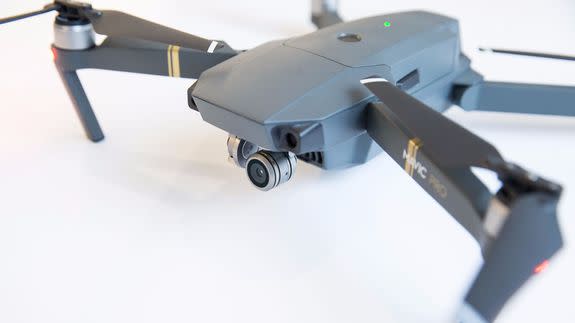
Owning a DJI Mavic Pro is a little like having a secret. The drone is so small, light and, most importantly, foldable, that it can easily fit in a backpack, a large handbag or even a car’s glove compartment. No one looking at me walking down the streets of Manhattan would know I have the power of flight in my backpack.
It’s more, though, than just the size that makes DJI’s new pro-sumer drone a winner. It’s expertly designed, smart and one of the easiest-to-fly drones I have ever encountered.
SEE ALSO: Pizza delivered by drone? It's been done for real in New Zealand
The $999 drone – and included remote – is unlike anything DJI has ever produced before. Gone are the smooth curves of DJI’s Phantom series. Instead you have a tough, gray plastic body and slightly military-looking lines that might remind you of a tiny tank. It weighs just 1.64 pounds and, folded, is 83x83x198 millimeters — about the size of a water bottle. The four rotors attach bayonet-style to the arms and, for the first time in my memory, there are no back-up blades.
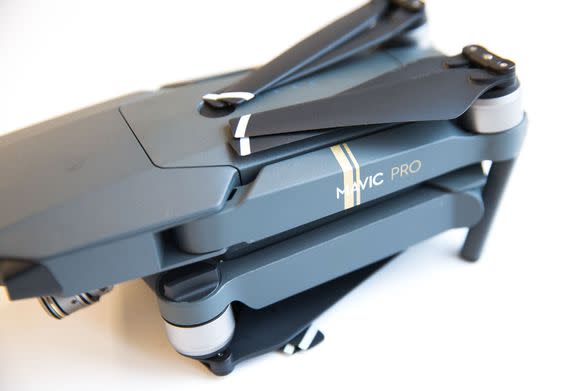
Image: lili sams/mashable
The highlight of the Mavic Pro’s construction, though, is its foldability. Two rotor arms fold out sideways, while the other two fold up from underneath. I have seen other folding drones and they are either confusing to open or feel pretty DIY. The Mavic Pro is solid folded, unfolding and unfolded. The set of four rotors are each split in half, so each blade moves freely and stays flexible even when you unfold the drone.
As you can probably guess by the price, and despite the foldability, this is not a toy drone. Its specs are impressive.
DJI’s Mavic Pro can climb at 16.4 feet per second up to 1,640 feet high as far as 8 miles away, and fly at up to 40 miles per hour. You, though, will do as I did and fly in beginner mode. It has a max speed of 27 miles per hour and only lets you fly the drone as far away as you can see it. It also has a max altitude of 400 feet — which is as high as FAA regulations (Part 107 Rule) will let amateur drone pilots fly.
Take off
Getting the Mavic Pro from unboxing to flight is about as simple as it could be. First you unfold the Mavic and then find an area clear of tall buildings, wires, planes, people and cars. You get the picture; it can be difficult to find legal places to fly a drone these days (also, don’t forget to get your $5 drone license at the FAA.gov).
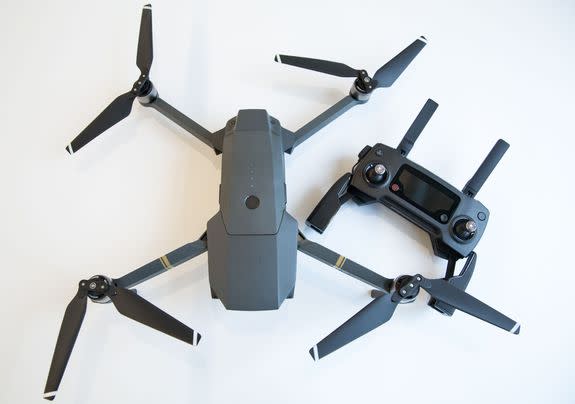
Image: LILI SAMS/MASHABLE
The Mavic Pro comes pre-paired with its shockingly small remote. This is easily my favorite drone remote ever. It’s light, rugged, comes with a built-in monochrome LED screen and grippers that fold out to hold your smartphone. You don’t need to use a smartphone to fly the Mavic Pro (you can also fly with just the phone app), but then you miss out on the live feed of what the Mavic Pro’s 12-megapixel, 4K gimbal camera can see. There is also a significant amount of touch-screen control added through the excellent, free DJI Go app.
As soon as you power up both the drone and the remote, they pair. The bottom of the remote unfolds and acts as a secure holder for your smartphone. The default plug on the drone one I tested was a micro USB. I flew the drone with both an iPhone 6 and a Samsung Galaxy S7. For the former, I had to use a separate lighting cable that plugged into a USB slot on the remote and then directly into the iPhone.
Take-off is easy and you even have two launch options: Lift-off through the app or via the remote-control joysticks. In the app, I selected the takeoff icon on the screen and then used an on-screen slider to initiate the take-off. Launching with the remote joysticks is more fun and maybe a tiny bit easier. To launch with this mode, you have to simultaneously push or pull the sticks to the inner or outer corners. Once the motors start, you release the joysticks and the Mavic Pro takes off. It’s drone flight simplified.
Like every other drone I’ve flown over the years, the Mavic Pro is full of sensors. It has ultrasonic sensors to know its altitude, so it automatically hovers to a little over a meter high, waiting for instructions. There are also forward-facing vision sensors for obstacle detection and, of course, a GPS and compass. Put simply, the Mavic Pro knows where it is, where it’s going and if there’s anything in its way.

Image: DJI
When I launched the Mavic Pro and started using the remote control, I was immediately impressed by its control. Not only is the Mavic Pro responsive, but I could precisely control its movements in a way I have never experienced before with a drone. While I comfortably flew in a large open field, I also successfully flew it in my tiny backyard, did a couple of test-flights inside my house and one in Mashable’s New York City studio space (without GPS, it had a little trouble responding to my land command).
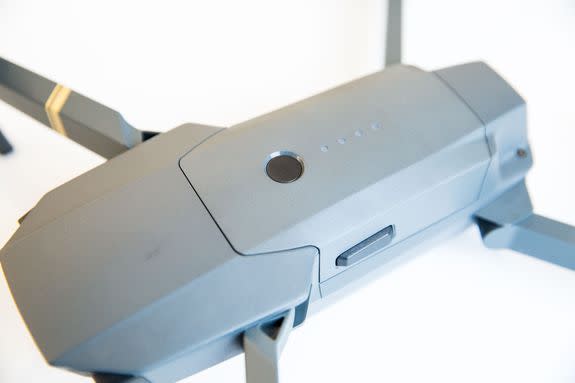
Image: LILI SAMS/MASHABLE
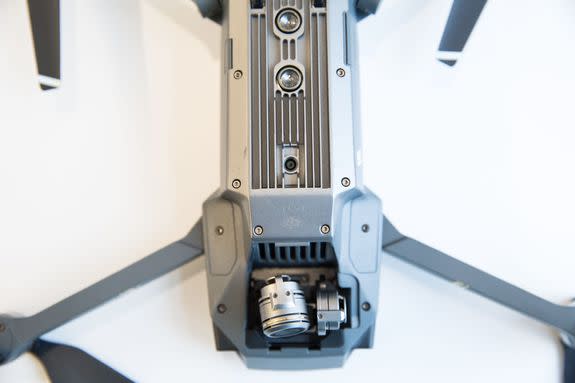
Image: LILI SAMS/MASHABLE
It also helps that, obviously, the Mavic Pro has built-in obstacle detection. Anytime the Mavic Pro got too close to anything and it would slow down or stop, the Obstacle Detection Bar on the app would turn orange and the remote would vibrate. I could not force it to run into anything. The drone can still back into stuff; there are no rear obstacle detection cameras.
If you want the Mavic Pro to respond more quickly (or radically) to the control and to fly at its max speed of 40 miles per hour, there’s a small slide switch on the side of the remote that lets you enable Sport Mode. I wouldn’t suggest drone newbies using this or enabling this mode indoors.
It’s also worth noting that the Mavic Pro is among the quietest drones I’ve flown. I’m not saying it’s not loud, but once you get it a hundred feet in the air or so, it’s fairly hard to hear.
Max intelligence
The Mavic Pro is also the first drone I’ve ever flown to include gesture recognition. It’s not on all the time, mind you. You choose Gesture control under Intelligent Flight Mode on the app and the drone will look for a subject (or you can use your finger on the screen to highlight an object) and watch for gestures.
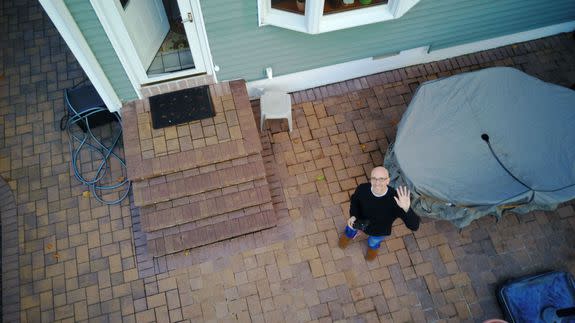
Image: Lance Ulanoff/mashable
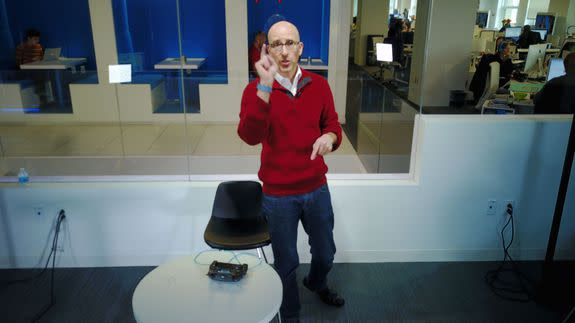
Image: LANCE ULANOFF/MASHABLE
To take a photo, I had to make a framing gesture with my hands in front of my face. The drone’s forward lights started blinking rapidly to signal it was about to take a picture, which also gave me time to pose. Other gestures I could use included one that looks like I’m running and one where I wave my arms in front of the drone, which seems to confirm the drone is at the right distance to track you or take a photo. All these gestures work better if you have someone other than yourself do them. It’s impossible to make hand signals and fly the drone at the same time. Trust me, I tried it.
Like the Phantom 4 drone before it, the DJI has a number of app-enabled flight modes that let it follow and track subjects so you can focus on getting the right shot. Trace tracks you at a constant distance, Spotlight will keep the camera trained on you as the you fly the drone around you or your selected subject, and Profile will keep the drone flying alongside of you while keeping you in the image frame. In all instances, I noticed that the intelligent tracking modes only worked if the drone was far enough away from me. Otherwise, the screen put me in a red box and warned the drone was too close, although it still seemed to track me. This came in handy when I wanted to put down the remote for a second to snap a drone selfie.

Image: LILI SAMS/MASHABLE
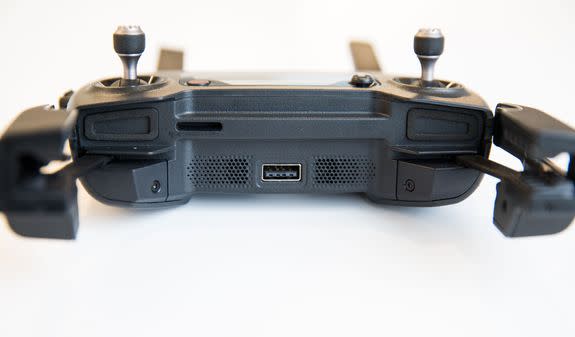
Image: LILI SAMS/MASHABLE
I also used the tap-to-fly mode to send the drone out to a point in the distance. At any time, I could hit a visible “Stop” button on the screen. I did use this once or twice because I feared I had accidentally tapped to have the drone fly right into a fence. My issue with the tap-to-fly feature is that it asks you to eyeball where you want the drone to go, but does not let you set the max distance away from you. I had the same issue with the Phantom 4 drone before it.
Really moving pictures
The Mavic Pro’s video quality is excellent. It defaults to 4K video and stores it on an onboard micro SD card.
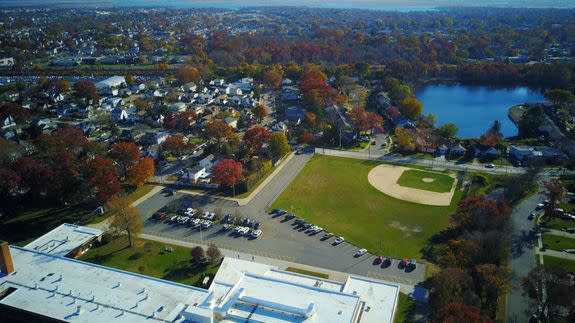
Image: Lance Ulanoff/Mashable

Image: Lance Ulanoff/mashable
I could use the joysticks to carefully point the camera at my subject or let the tracking do the work for me. The left scroll wheel on the remote also let me turn the camera a full 90 degrees so it was pointed directly at the ground.
The Mavic Pro is also a natively social drone, ready to stream live, 1080P video directly to your phone and Facebook Live (or YouTube’s streaming platform). The app also includes some simple video editing tools. It will let you download your footage, combine the clips and then let you edit it and share directly through the app.
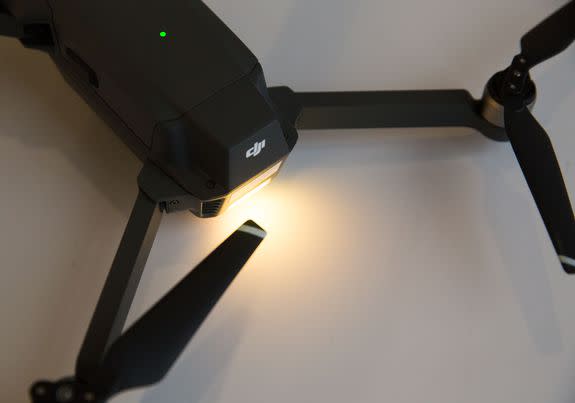
Image: LILI SAMS/MASHABLE
Despite its small size, the Mavic Pro regularly flew for 20 minutes or more in my tests. When the power drained to under 30 percent, the remote started vibrating. Then the remote would start beeping loudly. I kind of hated that. In fact, any error would cause that beeping. At one point, one scroll wheel was set to the wrong position for flight and the remote reported it with an error message and an ear-piercing beep that would not stop until I figured out the right setting for the wheel.
This minor annoyance aside, the DJI Mavic Pro is, by far, my favorite drone. You will pay for the convenience of its small size and foldability, but I think it’s worth it.
DJI Mavic Pro
The Good
Light • Small • Foldable • Easy launch • Excellent flier • Small, near-perfect remote • Excellent image quality
The Bad
Remote can get a little annoying with all its alerts.
The Bottom Line
Not just a great flier, the DJI Mavic Pro is a powerful, versatile drone that's small enough to share space in your backpack with your laptop.

 Yahoo News
Yahoo News 